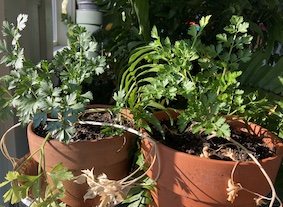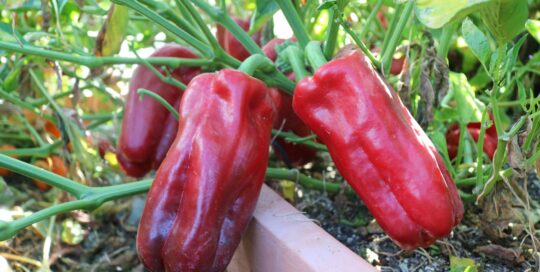Growing Parsley in Winter
Views: 510

Growing parsley in winter is one of the surprising gardening delights of the season. I was reminded of this during a recent walk through my neighborhood on a 32F day. In fact, it may have been colder than that. The otherwise brownish-hued community garden contained pops of green emitting from both this resilient herb and some still-strong kale. You know those photographs where the whole scene is black and white and somehow they’ve magically popped out red highlights? Well, this scene was similar but real-life magic.
I have kept parsley growing successfully in-ground well past New Year, and once or twice I’ve overwintered it into the next spring season. Here are two ways to keep your parsley growing strong for a second growing season.
Growing In Ground
Parsley can tolerate temperatures as low as 10F, which would put them at a USDA Plant Hardiness Zone of about 7b. You can extend this to colder zones with the help of an application of mulch in the fall or early winter. I’ve read tips that say to trim the parsley back before applying a 2-3 inch layer of mulch but I don’t recall that I did so and my parsley was fine through the winter. Use whatever mulch you have on hand. Why not make use of those fallen leaves and shred them up as a nice warming layer? If you don’t cut back the parsley, you might consider covering the plants with a type of row cover in addition to the mulch. This will help keep pesky nibbling creatures from chowing down on a crop you wish to keep through the season.
Come spring, your parsley plants will start growing whether you’ve removed the mulch or not. To get greener leaves sooner, remove some of the mulch. Give it some water if you’ve had a dry winter.
Growing Inside
If you’ve been growing parsley in containers outdoors as I have, you might find it a bit difficult to mulch it, unless you put the entire pot under a pile of mulch. If that’s not something you want to do, you can bring your parsley plants indoors. I repotted two small parsley plants into fresh potting soil and am keeping them in a sunny window in my minimally heated mudroom. You have two considerations for bringing those parsley plants indoors:
- Parsley has a long taproot, so do repot your plant into a deep pot.
- If you place your plants under a grow light, you might end up with too much of a good thing; i.e. they’ll become vigorous and bushy and maybe even grow too big for your lighting setup. If this is your first time growing parsley indoors, take it slow and start off with the pots in a sunny window, turning them every few days.
Two Parsley Side Notes
- Keep in mind that parsley is a biennial. That means it grows vegetatively for one year and then the next year it initiates its reproductive phase—in other words, it starts to flower. It’ll do so by sending up a thick stalk from which it develops flowers. Once parsley flowers, the plant is done. So why even keep parsley overwinter if it’s just going to flower and die the next late spring/early summer? Because a) you’ll get freshly harvested parsley up until then, which is always nice, and b) it’s a fun and educational challenge.
- I find that parsley leaves grown throughout the winter are slightly smaller and a bit tougher, even a bit more potent. Before using these winter-harvested leaves, give them a taste to judge how much to use in your dish.
Meet Ellen Wells
When you’re raised on a farm, you can’t help but know a thing or two about gardening. Ellen Wells is our expert on edible gardening.…
Ellen's Recent Posts

Pepper Red Impact an All-America Selections Winner






